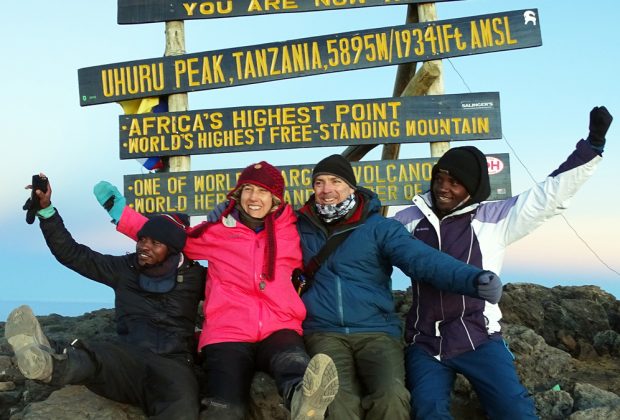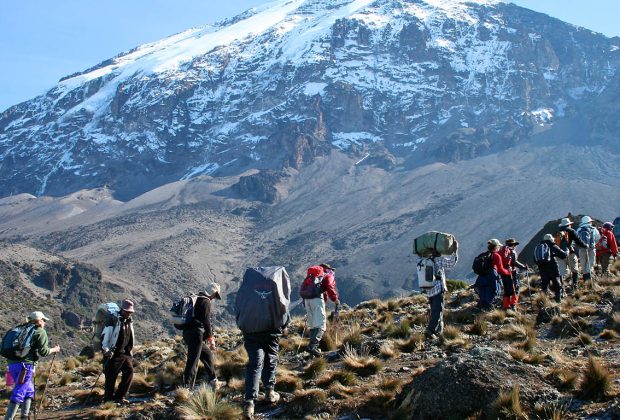9-Day Kilimanjaro Treks Via Lemosho Route



The Lemosho route on Mount Kilimanjaro offers stunning views, good acclimatization, and less crowding. It starts with a drive to Londorossi Gate, then through Shira Plateau. The gradual climb and various program lengths make it suitable for different climbers. Starting at a higher altitude helps with acclimatization. Overall, it’s a great option for reaching the summit of Africa’s highest peak.
DAY 1: TREKKING FROM LONDOROSI GATE TO MTI MKUBWA CAMP.
A guide and a mountain support crew will arrive at the hotel in the morning in order to meet you and hold another briefing, after which you will travel by vehicle (roughly 3-4 hours) to Kilimanjaro National Park’s western entrance: Londorossi Gate (2,200 m). After the quick formality of acquiring climbing permits and registering with the search and rescue service, the group will start trekking towards the first camp of the route: Mti Mkubwa Camp (2,780 m). Raincoats are necessary on this day in particular, as you will be walking through rainforest. By the time you reach the camp, our professional mountain crew will prepare everything necessary, put tents and cook lunch for you. After lunch the group will depart on an acclimatization hike towards Shira 1 Camp that features a 300meter gain in altitude, after which you will hike back down to Mti Mkubwa Camp, where a hot dinner will be waiting.
Note: The acclimatization hike is an easy trek with a slight gain in altitude done in order to speed up the acclimatization process. You should take the acclimatization hikes very seriously. They help increase your chances of successfully climbing Kilimanjaro and save you from the consequences of altitude sickness.
This will be your first day at this altitude, so it is strongly recommended you heed the following instructions from this point on:
Abstain from consuming alcohol and caffeine
Drink over 4 liters of bottled water daily (little by little, frequently)
Take a Diamox pill to help alleviate symptoms of altitude sickness. Most mountain climbers take Diamox in the morning, before they start their ascent, in order to reduce discomfort associated with altitude sickness. We recommend you consult your doctor prior to the trip in case of potential allergies.
At night you may experience discomfort associated with acclimatization to the high altitude: because of a reduction in your waking breathing pattern, your body gets less oxygen than during the day. Taking altitude into account, you may therefore start feeling sick and have a headache. Pay attention to your own body and tell your guide if you start feeling any symptoms of altitude sickness.
Acclimatization hike:
Change in Elevation: Mti Mkubwa Camp (2,780 m) — Destination point end route to Shira 1 Camp (3,095 m)
Hiking distance: 2 km
Hiking time: 1 hour.
DAY 2: TREKKING FROM MTI MKUBWA CAMP TO SHIRA 1 CAMP.
An early wakeup, breakfast, and a gradual trek upwards until 3,500 meters; at that point for the first time you will be able to see stunning views of Shira Plateau and Kibo Volcano.
On the whole, the passage from Mti Mkubwa Camp to the second high-altitude Shira 1 Camp (3,505 m) is rather easy and takes about 5-6 hours. This will allow you to start the acclimatization process gradually, which is a mainstay of good trekking. When you reach the camp, your team of specialists will cook you lunch and you will have the chance to rest in your tent or walk around the nearby area.
DAY 3: TREKKING FROM SHIRA 1 CAMP TO SHIRA 2 CAMP.
Departing from Shira 1 Camp (3,505 m) and a light trekking towards the second high altitude camp: Shira 2 Camp (3,900 m). This trek is not difficult and you will be able to enjoy spectacular views of Africa and the unique flora of Kilimanjaro and the surrounding area. Shira 2 Camp is the best place on the trip to see Mount Meru (the fifth summit of Africa), weather permitting.
When you arrive at camp you will have lunch, and after a two-hour rest everyone will complete an acclimatization hike towards Lava Tower Camp that features a 300meter gain in altitude.
Acclimatization hike:
Change in Elevation: Shira 2 Camp (3,900 m) — Destination point end route to Lava Tower (4,270 m)
Hiking distance: 2 km
Hiking time: 1–2 hours.
DAY 4: TREKKING FROM SHIRA 2 CAMP TO THE LAVA TOWER AND DESCEND TO BARRANCO CAMP.
After breakfast you will leave Shira 2 Camp (3,900 m) and start your way to the key point of the route: Lava Tower (4,630 m). This section of the route has a lot of ascents and descents that end in a camp at over 4,600 meters. It might be difficult, and you may feel some discomfort, but in order to successfully acclimate to the altitude you have to spend at least 1–2 hours here, so this is where lunch will be.
Then you will descend to Barranco Camp (3,960 m). Here you can see the famous Barranco Wall, impressive in both its massive size and steepness! Next day you will be climbing it, but don’t worry: it features a very simple hiking trail.
Note:
If one or more participants feel sick, the group may refrain from passing the Lava Tower and adjust the route, following instead the road for porters. In this case you will not reach an altitude of 4,630 meters, getting up only to a maximum of 4,400 meters.
DAY 5: TREKKING FROM BARRANCO CAMP TO KARANGA CAMP.
Early wakeup, breakfast and the start of summiting Barranco Wall (we recommend you leave the camp as early as possible to avoid crowds of the other groups). Hiking up the gorge wall is not difficult and only takes around an hour. After the climb you can have a rest and take photos in front of the Kibo volcano.
Then you start a more difficult hike to Karanga Camp, which features numerous ascents and descents during the route, but don’t worry: our guides are experts at choosing an optimal pace for the group. After reaching the camp you will be offered a warm lunch. After a couple of hours, you will have to complete an acclimatization hike in the direction of Barafu Camp with a 200-meter gain in altitude, and then descent back down to the camp.
Acclimatization hike:
Change in Elevation: Karanga Camp (4,035 m) — Destination point end route to Barafu Camp (4,270 m)
Hiking distance: 2.5 km
Hiking time: 1–2 hours.
DAY 6: TREKKING KARANGA CAMP TO BARAFU CAMP.
In the morning after breakfast you begin your way to Barafu Summit Camp (4,640 m), the starting point for a night summiting Uhuru Peak (5,895 m). Our team will set up a camp for you ahead of time, including tents and sleeping bags, so you can relax. After regaining strength, you have to complete an acclimatization hike towards the intermediate Kosovo Summit Camp (4,800 m) and then back to Barafu Camp, where you will be served a hot dinner. It is better to spend the remainder of the day resting and sleeping before night summiting.
Acclimatization hike:
Change in Elevation: Barafu Camp (4,640 m) — Kosovo Camp (4,800 m)
Hiking distance: 2 km
Hiking time: 1–2 hours.
DAY 7: ASCEND TO UHURU PEAK AND DESCEND TO MILLENNIUM CAMP.
Departure from Barafu Camp (4,640 m) at night and the start of summiting Kilimanjaro: Uhuru Peak (5,895 m). Technically the climb is relatively simple; however, the most challenging part is the high altitude. Each pair of climbers will get a personal guide for the entire ascent to monitor your physical and mental conditions. After your successful ascent to Uhuru Peak – the top of Mount Kilimanjaro and the last point of the climb on the Lemosho Route, you can descend to the nearest glacier if desired. Then you will return to Barafu Camp and after a 2-hour rest continue your descent to Millennium Camp (3,820 m).
Note:
Don’t forget that 90% of all accidents occur during the descent, including all broken arms and legs. Please pay attention to your feet, as there is a high risk of damaging your toenails.
DAY 8: DESCEND FROM MILLENNIUM CAMP TO MWEKA GATE.
The camp is situated in a tropical rainforest. When you wake up, you will feel relief from the reduction of the height and the satisfaction of reaching the summit. After a warm breakfast, you will head for the park’s exit: Mweka Gate (1,650 m). After your descent the whole group will gather to congratulate you, followed by offering you a chance to share your opinions on the climb in the guestbook. Lastly, we will present you with your commemorative certificates in our office and provide you a transfer back to the hotel.
DAY 9: DEPARTURE.
Rest in the hotel and transfer to the airport.
Note: Hotel check-out is at 11:00 AM. In case you need a late check-out because of an evening flight, there is the option to extend your hotel stay for an extra fee.
Inclusions:
- Accommodation: Lodging at Weru Weru River Lodge or similar.
- Meals: Breakfast, lunch, and dinner provided during the trek.
- Transportation: Transfer from Kilimanjaro International Airport to the lodge.
- Trekking Support: Experienced guide and mountain support crew.
- Climbing Permits: Acquisition of necessary permits for Kilimanjaro National Park.
- Equipment: Tents, sleeping bags, and other necessary camping gear.
- Activities: Trekking from Marangu Gate to Mandara Hut, Mandara Hut to Horombo Hut, Horombo Hut to Kibo Hut, and summiting Uhuru Peak.
- Briefings: Orientation and briefing sessions conducted by tour managers.
- Safety Measures: Registration with search and rescue service, as well as guidance on altitude sickness prevention.
- Certificates: Commemorative certificates upon successful completion of the trek.
Exclusions:
- International Flights: Airfare to and from Kilimanjaro International Airport.
- Travel Insurance: Personal travel insurance covering medical expenses, trip cancellations, and emergencies.
- Personal Expenses: Expenses for additional meals, beverages, souvenirs, and optional activities.
- Gratuities: Tips for guides, porters, and other staff members.
- Accommodation Beyond Itinerary: Any additional lodging required before or after the scheduled trekking dates.
- Airport Transfers: Transfers to the airport upon departure beyond the designated schedule.
- Visa Fees: Fees associated with obtaining entry visas for Tanzania, if applicable.
- Medical Expenses: Costs incurred for medical treatment or medications during the trek.
- Optional Activities: Any additional excursions or activities not specified in the itinerary.
What is Mount Kilimanjaro?
- Mount Kilimanjaro is the highest peak in Africa, located in Tanzania. It is a dormant volcano and one of the most iconic mountains in the world.
How tall is Mount Kilimanjaro?
- The summit of Mount Kilimanjaro, called Uhuru Peak, stands at an elevation of 5,895 meters (19,341 feet) above sea level.
How long does it take to climb Mount Kilimanjaro?
- The duration of a Kilimanjaro climb varies depending on the route chosen. Most climbs typically range from 5 to 9 days.
What are the different routes up Mount Kilimanjaro?
- There are several routes to the summit of Kilimanjaro, each with its own characteristics and scenery. Popular routes include the Marangu, Machame, Lemosho, Rongai, and Northern Circuit routes.
Is climbing Mount Kilimanjaro difficult?
- Climbing Kilimanjaro is challenging due to its high altitude, but it doesn’t require technical climbing skills. However, climbers should be physically fit and prepared for the rigors of high-altitude trekking.
Do I need a guide to climb Mount Kilimanjaro?
- Yes, it is mandatory to have a registered guide accompany you on your Kilimanjaro climb. Guides are essential for safety, navigation, and providing support throughout the trek.
When is the best time to climb Mount Kilimanjaro?
- The best times for climbing Kilimanjaro are during the dry seasons, which are typically from late June to October and from December to March. These months offer clearer skies and better trekking conditions.
What should I pack for climbing Mount Kilimanjaro?
- Essential items for climbing Kilimanjaro include proper clothing for varying temperatures, sturdy hiking boots, a good quality sleeping bag, trekking poles, personal medications, and other necessary gear as recommended by your tour operator.
What are the risks of climbing Mount Kilimanjaro?
- The main risks of climbing Kilimanjaro include altitude sickness, which can affect anyone regardless of fitness level, as well as other potential hazards such as extreme weather conditions and physical exhaustion.
Do I need to train before climbing Mount Kilimanjaro?
- Yes, it is highly recommended to undergo physical training and preparation before attempting to climb Kilimanjaro. This can include cardiovascular exercises, strength training, and hiking to build endurance and fitness levels.
